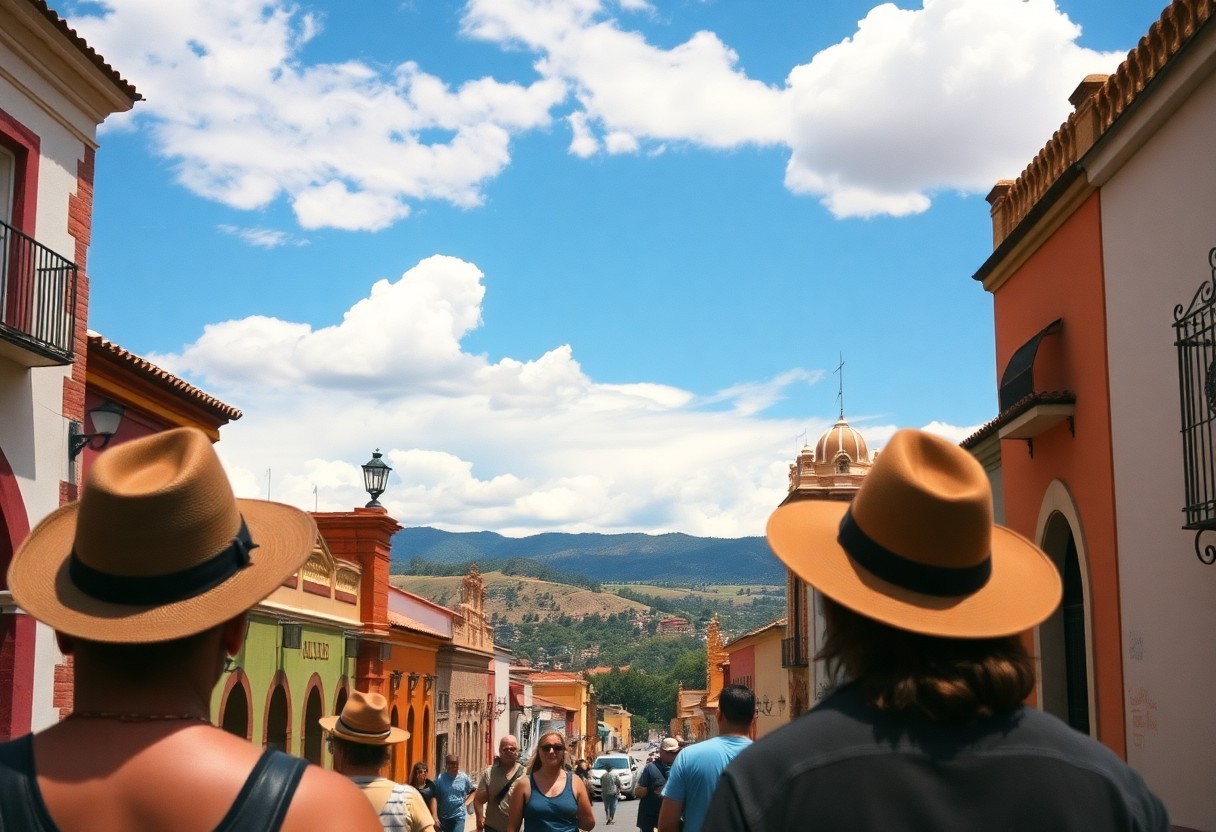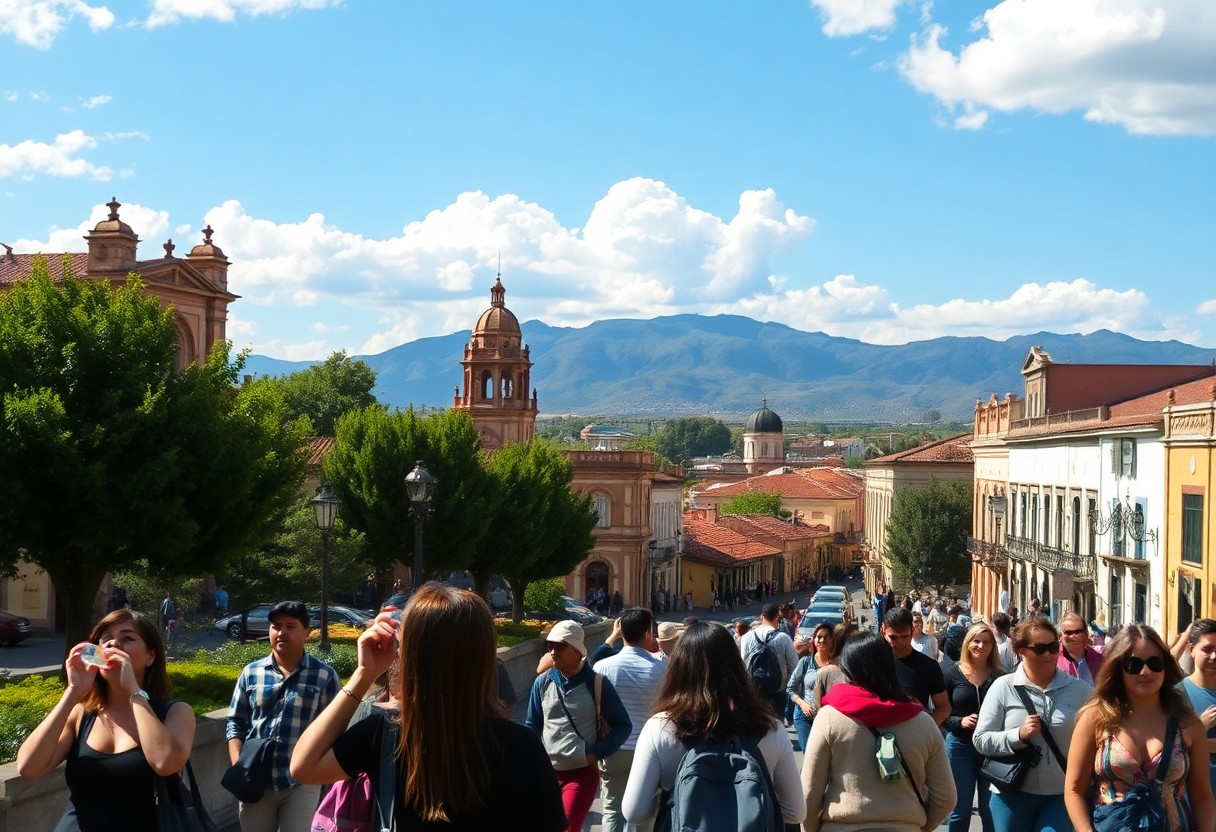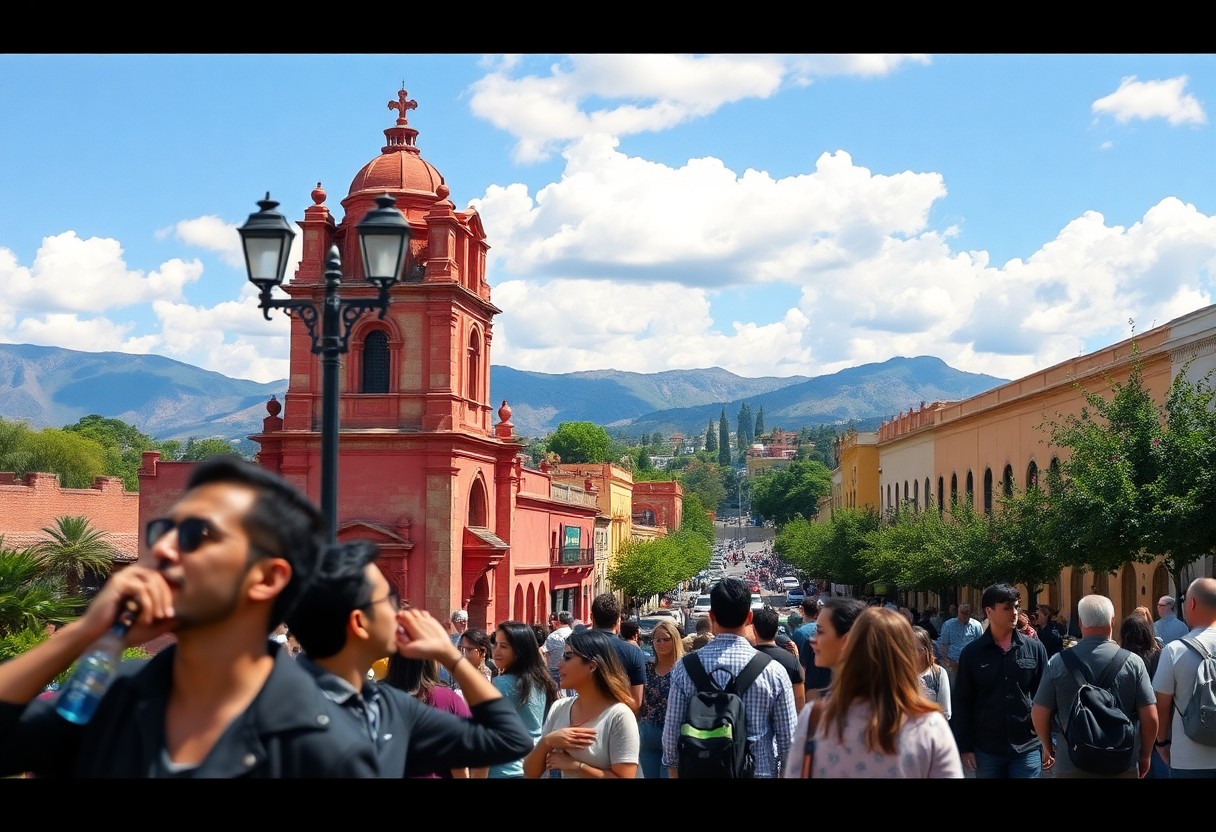San Miguel de Allende is renowned for its stunning beauty and unique charm, yet one surprising aspect that catches many travelers off guard is its impressive elevation. Situated at an impressive 6,200 feet above sea level, this enchanting city presents certain altitude challenges that can significantly shape your travel experience. As your body adapts to the thinner atmosphere, you may experience symptoms such as mild headaches, shortness of breath, or feelings of fatigue. While these effects are generally temporary and manageable, they can be uncomfortable for some visitors. By understanding how altitude impacts your body and preparing adequately prior to your visit, you can ensure a more enjoyable and comfortable journey to this stunning Mexican treasure. Staying properly hydrated, pacing yourself during various activities, and listening to your body's signals will allow you to fully appreciate the high-altitude allure of San Miguel de Allende.

Enhance Your Travel Adventure: Grasping the Altitude and Climate of San Miguel de Allende
The remarkable altitude of San Miguel de Allende is a significant factor that shapes its distinctive climatic conditions, profoundly influencing your overall travel experience. The city’s location in the Mexican highlands exposes visitors to specific altitude challenges that can affect both comfort and health during your stay. By being informed about these environmental factors, you empower yourself to prepare effectively and adapt seamlessly to the local climate, ultimately enhancing your overall enjoyment of this extraordinary destination.
Key Elevation Insights for Travelers Planning Their Journey
San Miguel de Allende is situated at an impressive altitude of 6,132 feet (1,870 meters), making it a notable high-altitude destination. This significant elevation can lead to various physiological responses in visitors, including mild symptoms of altitude sickness or changes in respiration patterns. You might experience slight breathlessness during your initial days, especially when partaking in physical activities such as hiking or exploring the city. Recognizing this aspect of your journey can help you plan appropriately and alleviate any discomfort, allowing you to fully immerse yourself in the beauty and culture that San Miguel de Allende has to offer.
Exploring the Unique Climate Features of San Miguel de Allende
The climate in San Miguel de Allende is characterized by its mild temperatures and relatively dry conditions, making it an attractive destination year-round. Visitors can expect warm days accompanied by cool nights, resulting in notable temperature fluctuations across different seasons. The high-altitude environment contributes to a pleasant climate that attracts numerous international visitors seeking a delightful escape from their daily routines.
This beautiful city experiences a semi-arid subtropical highland climate, featuring clearly defined dry and rainy seasons. The dry season, which typically spans from November to April, offers plenty of sunshine with minimal rainfall, whereas the rainy season lasts from May to October, introducing refreshing afternoon thunderstorms that rejuvenate the landscape. When planning outdoor activities, it’s crucial to consider these seasonal changes and dress in lightweight layers to easily adapt to the varying temperatures throughout the day.
Recognizing and Understanding Common Altitude Symptoms
If you're gearing up for a visit to San Miguel de Allende, which rests at an elevation of around 6,200 feet, being aware of potential altitude-related symptoms you may experience is essential. At this notable altitude, your body may undergo various physiological changes that could impact your comfort and health, potentially leading to mild to moderate discomfort during your initial days in this beautiful Mexican locale.
Identifying Common Symptoms Encountered by Visitors at High Altitudes
During your stay in San Miguel de Allende, you may encounter a variety of altitude-related symptoms, ranging from mild to more intense experiences. Many visitors report symptoms such as headaches, fatigue, shortness of breath, and occasional dizziness. Additionally, some travelers may notice a decreased appetite, mild nausea, and disrupted sleep patterns as their bodies adapt to the higher elevation. Being aware of these symptoms can help you prepare for your trip and respond appropriately to your body’s needs, ensuring a more enjoyable experience.
Understanding the Key Factors That Influence Altitude Symptoms
Several critical factors can significantly influence your altitude experience while staying in San Miguel de Allende:
- Personal fitness level
- Hydration status
- Previous exposure to high altitudes
- Age and overall health condition
Understanding these factors equips you with valuable insights to prepare adequately for your visit, ensuring a smoother transition to the high-altitude environment and enhancing your overall enjoyment of this captivating city.
Thorough Examination of the Influencing Elements on Altitude Experience
Various elements contribute to your experience of altitude in San Miguel. Key factors include:
- Physical conditioning and stamina
- Speed of acclimatization
- Cardiovascular health
- Genetic predisposition to altitude effects
Understanding these nuanced influences can greatly affect your acclimatization strategy and improve your overall comfort during your visit, allowing you to fully enjoy the breathtaking surroundings of San Miguel de Allende.

Effective Prevention Strategies and Health Recommendations for Travelers to San Miguel de Allende
Visiting San Miguel de Allende at 6,200 feet elevation necessitates thorough preparation to effectively manage potential altitude effects. It is essential to approach your journey with proactive health strategies that can minimize risks and enhance your overall comfort. By understanding and implementing specific prevention methods, you can significantly reduce the likelihood of experiencing altitude-related symptoms and fully enjoy your adventure in this magnificent Mexican city.
The Crucial Role of Staying Hydrated
Preventing altitude sickness begins with maintaining excellent hydration. It is recommended to consume more water than usual, aiming for at least 3-4 liters daily. Your body requires increased fluid intake to compensate for elevated respiratory rates and potential fluid loss that occurs at higher elevations in San Miguel de Allende. Staying hydrated is fundamental to ensuring that your body adjusts effectively to the altitude, minimizing the risk of discomfort.
Acclimatization Techniques to Enhance Your Comfort Level
Health and wellness experts recommend gradual altitude adaptation strategies for visitors to San Miguel. It is wise to plan your first few days with minimal physical exertion, allowing your body to adjust naturally to the altitude. Engaging in slow movements, taking frequent rest breaks, and avoiding strenuous activities will assist your physiological systems in acclimatizing effectively.
Thus, achieving successful acclimatization requires a strategic approach to your daily activities. Spending your initial days at a relaxed pace, incorporating leisurely walks, and paying attention to your body’s signals will be beneficial. Monitoring your energy levels and avoiding rapid ascents can significantly alleviate altitude-related stress, enabling you to appreciate the beauty and culture that San Miguel de Allende offers.
Nutritional Guidelines for Thriving at High Altitude
In addition to hydration, your dietary choices play a crucial role in your altitude adaptation. It is beneficial to consume high-carbohydrate, low-salt meals that support metabolic processes and help maintain energy levels throughout your day. Light, nourishing foods will assist your body’s adjustment to the elevated environment of San Miguel, making your experience more enjoyable.
The importance of nutrition cannot be overstated when visiting high-altitude destinations. Focus on easily digestible proteins, complex carbohydrates, and foods rich in potassium. Avoiding heavy, greasy meals while maintaining a balanced diet will support your body's adaptation to the unique challenges posed by the high elevation of San Miguel de Allende, allowing you to feel your best during your stay.
Personal Experiences and Reflections from the Beautiful San Miguel de Allende
Throughout my journey in San Miguel de Allende, I encountered firsthand the profound effects of its high-altitude environment. At an elevation of 6,200 feet above sea level, the thin air posed challenges to my physical adaptation, creating a unique experience that reshaped my understanding of travel and personal resilience. The subtle effects of the elevation on my breathing and energy levels provided a fascinating exploration of how our bodies respond to significant geographical changes, enhancing my appreciation for this beautiful destination.
Sharing Experiences from Fellow Travelers About Their Altitude Adventures
Travelers frequently highlight their unexpected physiological responses to the altitude in San Miguel by sharing personal accounts. Many describe experiencing initial lightheadedness, reduced stamina, and a need to move slowly. Your first days may involve gentle acclimatization, with some visitors encountering mild symptoms such as headaches or slight fatigue, while others adapt more quickly to the elevated environment. These shared experiences offer valuable insights for newcomers, helping them prepare for their own adventures.
Practical Coping Strategies for Visitors Navigating Altitude Challenges
Visitors to San Miguel discover effective strategies for managing altitude-related challenges. It is essential to prioritize hydration, consume lighter meals, and pace activities accordingly. Simple techniques such as deep breathing exercises and incorporating frequent rest breaks can significantly diminish potential discomfort while you explore this captivating city. Your body’s adaptation is influenced by various factors, including physical fitness, hydration levels, and individual physiological responses.
Experts suggest a gradual increase in activity levels, avoiding alcohol initially, and opting for foods rich in complex carbohydrates. Consulting local healthcare professionals who are knowledgeable about the specific altitude dynamics of San Miguel de Allende can ensure a safe and enjoyable experience in this remarkable destination, allowing you to make the most of your visit.

Expert Health Recommendations for Travelers at High Altitudes
When visiting San Miguel de Allende, it’s crucial to consider altitude-related health factors. Healthcare professionals strongly advise visitors to prioritize their well-being by understanding the potential physiological challenges that accompany being at an elevation of 6,400 feet. Your body requires time to acclimate; implementing proactive strategies can help minimize altitude-related discomfort, ensuring a more enjoyable experience.
Expert Insights and Advice from Healthcare Professionals
Among medical experts, there is a clear consensus: gradual acclimatization is your best defense against altitude sickness in San Miguel de Allende. Planning to rest during your first 24-48 hours, staying well-hydrated, and avoiding strenuous activities is essential for a smooth adjustment. Your physician may suggest preventative medications or supplements to assist your body’s adaptation to the higher elevation, ensuring a more comfortable stay.
Accessing Specialized Health Resources for Travelers
San Miguel de Allende offers comprehensive support for altitude-related concerns, from local clinics to specialized travel health centers. You can find medical professionals who understand the unique challenges of high-altitude environments and can provide tailored advice for your specific health needs, ensuring that any potential issues are addressed promptly.
Given the city’s popularity with international travelers, specialized medical resources are readily available. You'll encounter English-speaking healthcare providers, diagnostic facilities, and emergency services equipped to manage altitude-related medical issues. Many hotels and tourist centers are well-informed and can provide immediate referrals and assistance, ensuring you receive prompt medical attention if necessary.
Essential Takeaways for an Enjoyable Visit to San Miguel de Allende
At elevations above 7,000 feet, San Miguel de Allende presents unique altitude challenges that can significantly affect your travel experience. It’s vital to prepare by staying well-hydrated, moving at a leisurely pace, and allowing your body ample time to acclimate. During your initial days, you might notice mild symptoms such as shortness of breath or slight headaches, which are common at this altitude. By drinking sufficient water, consuming light meals, and avoiding alcohol initially, you can minimize potential discomfort. Pay close attention to your body, take breaks as needed, and relish the breathtaking beauty of this colonial city without overexerting yourself. By taking the time to prepare thoughtfully, you can ensure a comfortable and unforgettable visit to this high-altitude Mexican gem.
Your Questions Answered: Frequently Asked Questions (FAQ)
What is the elevation of San Miguel de Allende, and why is this elevation significant for visitors?
San Miguel de Allende is situated at approximately 6,200 feet (1,890 meters) above sea level. This high altitude can lead visitors to experience mild symptoms, including shortness of breath, headaches, and fatigue. The thinner air at this elevation means reduced oxygen availability, which can affect physical performance and comfort levels for travelers who are not accustomed to mountainous environments.
What altitude-related health precautions should travelers observe when visiting San Miguel?
Visitors should ensure they stay hydrated, consume light meals, and limit alcohol intake during their first 24-48 hours. Gradually engaging in physical activities will assist your body in adapting to the elevation. Walking slowly, resting frequently, and employing deep breathing techniques can help minimize potential altitude-related discomfort. It is advisable for individuals with pre-existing respiratory or cardiovascular conditions to consult a healthcare professional prior to travel.
Are there specific times or seasons when altitude effects are more pronounced in San Miguel de Allende?
Altitude effects can be more pronounced during the dry season (November-April) when air is thinner and humidity is lower. Visitors arriving during the winter months may experience heightened symptoms. Additionally, daytime temperatures and sun exposure can also intensify altitude sensitivity. Wearing layers, remaining hydrated, and allowing adequate time for physiological adjustment can help alleviate potential challenges.
The Article: Altitude in San Miguel de Allende: How It Affects Visitors and What to Do About It appeared first on https://fallinginlovewithsanmiguel.com/
The Article Altitude in San Miguel de Allende: Impact on Visitors and Tips Was Found On https://limitsofstrategy.com



I couldn’t agree more with your points about San Miguel de Allende! The elevation really does surprise many first-time visitors, and it can definitely turn into a double-edged sword. On one hand, the city’s breathtaking views and unique charm are truly something special, but coping with altitude sickness can feel like a bit of a hurdle if you’re not prepared.
You hit the nail on the head with that one! San Miguel de Allende really knows how to lift you up—literally! It’s like one minute you’re admiring the view from a rooftop terrace, and the next you’re winded from a casual stroll to the café. It’s like the city’s quirky way of reminding you that life’s not just about the stunning architecture; you’ve also got to keep your lungs in shape.
“Absolutely! Staying informed and prepared can make all the difference—check out this helpful guide for tips on how to enjoy San Miguel de Allende to the fullest!”
https://britsocdermpath.co.uk/ChocolateHealth
You know, I’ve always been fascinated by how altitude can really change the way we experience a place. I remember my first time at a high elevation—just a short hike at about 8,000 feet left me winded! It’s wild how the body reacts, right? San Miguel de Allende might be beautiful, but it definitely requires some adjustment, especially if you’re coming from sea level. Those mild headaches and shortness of breath can sneak up on you. Drinking lots of water is key, and I found that taking it slow really helped me enjoy the stunning views without feeling too overwhelmed.
I appreciate your insights on altitude and its impact on our experience of place. It’s interesting how something as simple as elevation can completely reshape our physical sensations and alter our appreciation of nature. That first hike at 8,000 feet—often we think we’re prepared, but the body has its own way of reminding us of its limits.
“I totally get what you’re saying about the effects of altitude! If you’re planning a trip to higher elevations, check out this guide for tips on how to acclimate and make the most of your experience.”
https://britsocdermpath.co.uk/FaceTune